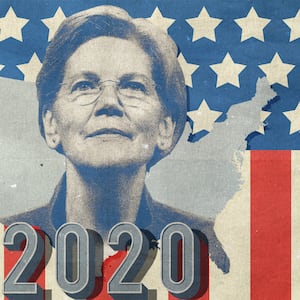Welcome to Pay Dirt—exclusive reporting and research from The Daily Beast’s Lachlan Markay on corruption, campaign finance, and influence-peddling in the nation’s capital. For Beast Inside members only.
As the 2020 Democratic presidential field grows, and a host of additional candidates eye an entry into the race, PAY DIRT has no doubt that, behind the scenes, candidates and their staffs are plotting ways to maximize the money available to their campaigns over the next two years.
More often than not, that means effectively planning out ways of coordinating with an “independent” political group, probably a super PAC, without running afoul of federal laws barring candidate coordination with such groups.
ADVERTISEMENT
How exactly this cycle’s candidates are doing so is information designed to stay secret. But we sat down with a prominent Republican political consultant who’s worked with multiple presidential campaigns—you may remember him from a previous PAY DIRT, where we explored the concept of dark-money “cap space”—to discuss how, theoretically, a campaign might go about circumventing anti-coordination laws to establish an “independent” political machine.
A savvy candidate’s first step, this consultant said, is generally to create an allied 501(c)(4) “dark money” group and put his or her chief of staff or another senior aide in charge. These groups must spend at least half of their money on apolitical “social welfare” activity. But the sorts of things they can do can be tremendously beneficial to a campaign. And because dark-money groups only disclose information about their finances to the IRS once a year, such groups can fly under the radar for months before anyone notices them.
“My c4 can pay for research and education,” the consultant explained, including voter modeling in key states. “My c4 might even go so far as to set up, I dunno, a ground operation in Iowa talking about an issue that is important to me and raise awareness about this issue.”
The next step, before actually declaring a candidacy, is to set up the super PAC. That group can immediately take possession of all the research the c4 has gathered on voters in the soon-to-be-candidate’s target states. “All that polling data, analytics, does not now have to be paid for by my [super PAC] so it can now use the vast majority of its money for direct voter contact.”
The super PAC “is also where I’m gonna park some of my consultants.” The 2020 Democratic one is shaping up to be crowded, and there are only so many experienced operatives to go around. So the ability to write big checks to talented staffers before a campaign officially launches is crucial to effectively staffing up once the candidate declares.
Once the super PAC is all staffed up, the whole political operation sits down together and plots out strategy as far into the future as it can. Crucial to this planning, the consultant said, is advertising strategy, since it’s the primary activity where campaign-super PAC coordination is scrutinized, and once the candidate officially jumps in the race, these conversations will be forbidden.
“This is where all the data work your c4 has done in terms of identifying audience is huge,” the consultant said. “Everyone agrees this is the demographic we want to talk to, this is the strategy.”
Once the planning is in place, the candidate can officially declare. From that point on, he or she can’t strategize with the super PAC. But there are hosts of creative ways of getting around that ban, even in the realm of advertising.
As PAY DIRT readers know well, detailed information on political ad buys is publicly available. So when the super PAC takes out an ad, the campaign can see exactly where it will run, and vice versa. “So the super PAC lays down their [ad buy] first, here here here and here, and then the campaign can look” to see where to fill the gaps. Through those unspoken signals, “the super PAC can say, don’t worry about this, we’re going to cover this three-week stretch in South Carolina.”
Another strategy is to strategically pull ad buys knowing the other party will see it. “The campaign will lay down some of its buys, and the wink and the nod is if you pull your ads here that means that’s where you’re gonna buy,” the consultant explained.
The strategies can be even more tricky as campaigns attempt to share polling data, the consultant said. “If someone were less concerned with optics and ethics, they would set up a Twitter account that was just @L451612, and it trickles out numbers and letters that don’t necessarily make sense unless you know what those numbers are supposed to mean.”
Other common strategies are “unlisted” YouTube channels and websites, web addresses for which have been shared among the campaign and super PAC ahead of time, but which no one else knows. The campaign can upload polling data or other information, the super PAC can log on and find that, but technically the two haven’t communicated, and hence escape the legal definition of coordination.
These are all strategies that Democrats may employ this year. But though President Trump has leaned heavily on super PACs in the past, the consultant noted that a major part of their utility—keeping the candidate’s hands clean as an “independent” group goes negative—is largely moot for a Trump re-election effort.
“On our side, ordinarily you’d have a super PAC—America First or the RNC or a combination of both—going after your opponent, carrying the ax,” the consultant said. “But with this president, he has no compulsion whatsoever about being the ax man.”







